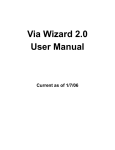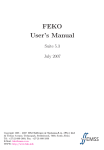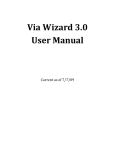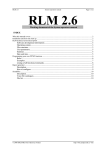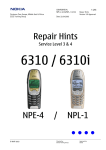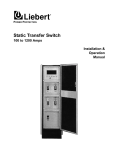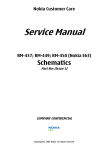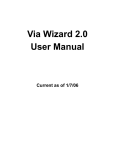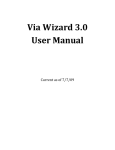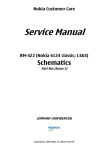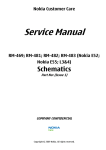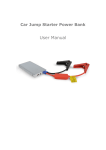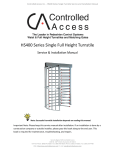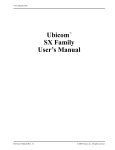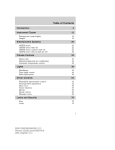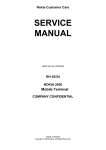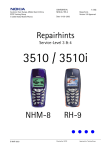Download 6a - Baseband Troubleshooting
Transcript
Nokia Customer Care RH-29 Series Cellular Phones 6a - Baseband Troubleshooting Issue 1 05/2004 Copyright © 2004 Nokia Corporation Company Confidential Page 1 RH-29 Company Confidential 6b - Baseband Troubleshooting Nokia Customer Care Table of Contents Page No Introduction to RH-29 Troubleshooting ........................................................................................... 3 General guidelines for RH-29 troubleshooting ............................................................................ 3 Tools needed for troubleshooting ................................................................................................. 3 General guidelines............................................................................................................................. 3 Nominal current consumption .......................................................................................................... 4 Troubleshooting Paths............................................................................................................................ 5 Dead or jammed device ...................................................................................................................... 5 Partially damaged device ................................................................................................................... 6 Most common symptoms reported by customer ......................................................................... 6 Most common symptoms for audio problems........................................................................... 6 Symptoms related to energy management ................................................................................ 6 Problems related to UI module:..................................................................................................... 6 Most common RF related symptoms: .......................................................................................... 6 ASIC is changed .................................................................................................................................... 7 UEM changed...................................................................................................................................... 7 UPP_WD2 changed ........................................................................................................................... 7 ZOCUS changed.................................................................................................................................. 7 Test points .............................................................................................................................................. 7 “CONTACT SERVICE” on display ........................................................................................................ 8 1CK Baseband HW Subarea Troubleshooting.................................................................................. 9 Flashing troubleshooting .................................................................................................................... 9 Energy management troubleshooting ..........................................................................................11 Device does not stay on................................................................................................................ 11 General power checking ............................................................................................................... 12 Power key troubleshooting .......................................................................................................... 14 Clocks troubleshooting.................................................................................................................. 14 Charging checking.......................................................................................................................... 16 Energy management calibration ................................................................................................ 19 ADC-reading..................................................................................................................................... 20 Backup battery ............................................................................................................................... 21 SIM card ............................................................................................................................................ 22 Memory troubleshooting ..................................................................................................................26 Serial interface troubleshooting ....................................................................................................27 CBUS................................................................................................................................................... 27 FBUS ................................................................................................................................................... 28 MBUS.................................................................................................................................................. 28 MMC troubleshooting .......................................................................................................................29 Vibra .......................................................................................................................................................30 ZOCUS ....................................................................................................................................................31 UI Module Troubleshooting ............................................................................................................... 32 Keymat backlight ................................................................................................................................32 Keyboard problem ..............................................................................................................................33 Display blank ........................................................................................................................................34 Image on display not correct ..........................................................................................................35 Backlight does not turn on .............................................................................................................36 Handportable audio ...........................................................................................................................37 Accessory Audio ..................................................................................................................................40 Page 2 Copyright © 2004 Nokia Corporation Company Confidential Issue 1 05/2004 Company Confidential RH-29 6b - Baseband Troubleshooting Nokia Customer Care Introduction to RH-29 Troubleshooting This document is intend to be a guide for localizing and repairing electrical faults in the RH-29 device. First there is a brief guide for fault localizing. Then fault repairing is divided into troubleshooting paths. Before any service operation you must be familiar with the RH-29 product and module level architecture. You have to also be familiar with the RH-29 specified service tools such as the Phoenix service software, flashing tools and software. General guidelines for RH-29 troubleshooting Tools needed for troubleshooting • Service tools (as listed at service tools chapter in service manual) • Laboratory power supply with current indicator • Oscilloscope • Digital multimeter General guidelines If the device cannot be turned on by any means, see “dead device” troubleshooting Current consumption (missing consumption) gives an idea whether the device is able to start up. Dropping supply voltage or very large current consumption indicates a short circuit Check whether the connection with Phoenix works and what can be discovered with Phoenix (ADC-readings, baseband self-test, BB-calibrations etc.) Check baseband self-tests with Phoenix if “CONTACT SERVICE” is shown on the display. Check visually display and rocker faults. Force phone to LOCAL mode and make keyboard test by phoenix. Check that board-to-board connector is OK, and connectors make good contacts. If liquid damage, stop repairing! Flash the phone before disassembling it, if the fault is not obvious and the Phoenix connection is OK. Disassemble phone: Try to locate failed module. Issue 1 05/2004 Copyright © 2004 Nokia Corporation Company Confidential Page 3 RH-29 Company Confidential 6b - Baseband Troubleshooting Nokia Customer Care Check failed module visually: Mechanical damages? Solder joints OK? Continue with specific troubleshooting procedure for the module: If there is an obvious fault, repair it before reflashing the device. Flash first if a fault is not obvious. If flashing is not working go to flashing troubleshooting. Due to CSP packages short circuits or broken solder joints are not easily seen. If the examined signal seems to be continuously in low or high level, then measure for possible short circuit to ground (signal low) or to supply voltage (signal high) Note that if a problem is not found from any visible contact/component it can be under CSPs where the signal is connected. Care must be taken when assembling and disassembling the transceiver. Failure to do this may result in unnecessary damage to device. Nominal current consumption NOTE: Service tools need some amount of current to work. The following current consumption values are measured from a complete RH-29. Vbatt = 3.6V Measured nominal currents are drawn from the main battery. Measurements have been made with a current probe connected to an oscilloscope. Operating mode Current consumption Idle 90 mA 2w audio call (backlights off) 250 mA Page 4 Copyright © 2004 Nokia Corporation Company Confidential Issue 1 05/2004 Nokia Customer Care Company Confidential RH-29 6b - Baseband Troubleshooting Troubleshooting Paths Dead or jammed device Disassemble yes Check UI connector Replace UI module Issue 1 05/2004 Copyright © 2004 Nokia Corporation Company Confidential Page 5 RH-29 Company Confidential 6b - Baseband Troubleshooting Nokia Customer Care Partially damaged device If the device is working, but some functionality is missing try to localize where the problems is and see relevant part of this manual. E.g audio is not working see “Audio Troubleshooting”, if charging is not working see chapter Charging troubleshooting etc. Most common symptoms reported by customer In this chapter is described most common symptoms reported by customers when the device is brought in for service. Some tips where the trouble can be found are given also. When troubleshooting use these tips and follow the given troubleshooting path. Most common symptoms for audio problems “Earpiece sound is missing” ”Handsfree sound is missing” ”Headset is not recognized” ”Microphone is not working” ”Volume cannot be adjusted” ” Ringing tones does not work” ”Audio volume too low” If symptom is something like above see audio troubleshooting. Symptoms related to energy management “Phone does not stay on” ”Charging is not working” ”Time is lost during battery change” ”Charging takes too long” ”Operating time is very short” These symptoms lead to relevant part of energy management troubleshooting Problems related to UI module: “UI-module keypad is not working” ”Backlight is dim” ”Backlight not even” ”Backlight is blinking” ”Keypad or display backlight is not working” ”Display related problems” See UI- module troubleshooting. Most common RF related symptoms: “Call cannot be made” ”Phone does not find signal” ”Call is often dropped” See RF troubleshooting Page 6 Copyright © 2004 Nokia Corporation Company Confidential Issue 1 05/2004 Company Confidential RH-29 6b - Baseband Troubleshooting Nokia Customer Care ASIC is changed ASIC’s can be changed only at a defined service level. UEM changed If UEM is changed baseband calibrations should be made. New IMEI must be programmed also. ZOCUS calibration is not necessary. UPP_WD2 changed IMEI must be reprogrammed. ZOCUS changed Zocus must be re-calibrated Test points Test Point Signal Test Point Signal Test Point Signal J109 UEMInt J203 TXQD J477 SIM IF J123 SLEEPCLK J204 AUXD J482 MMC IF J124 SLEEPX J311 FLASH CE J483 MMC IF J125 PURX J312 FLASH CE J484 MMC IF J170 RFCLK_I J314 SDRAMCLK J485 MMC IF J190 EARDATA J315 FLASH CLK J487 MMC IF J191 MICDATA J334 Shutdown Audio PA J488 MMC IF J192 SIMIODAI J390 Current sense resistor J490 MMC IF J193 SIMCLKI J391 Current sense resistor J492 MMC IF J194 SIMIOCTRL J392 Current sense resistor J493 MMC IF J195 MBUSTX J393 Current sense resistor J495 MMC IF J196 MBUSRX J470 SIM IF J496 MMC IF J197 FBUSTXI J471 SIM IF J497 MMC IF J198 FBUSRXI J472 SIM IF J498 MMC IF J199 RFCONVCLK J473 SIM IF J499 MMC IF J200 RXID J474 SIM IF J201 RXQD J475 SIM IF J202 TXID J476 SIM IF Issue 1 05/2004 Copyright © 2004 Nokia Corporation Company Confidential Page 7 RH-29 Company Confidential 6b - Baseband Troubleshooting Nokia Customer Care “CONTACT SERVICE” on display CONTACT SERVICE on display (Self-tests by Phoenix) Display information: “Contact Service” This fault means that software is able to run and thus the watchdog of UEM can be served. Self-test functions are executed when the phone is powered on and if one or more selftest functions fail, the message “Contact Service” is shown on the display. MCU self-test cases can be split into two categories: The ones that are executed during power up and the ones that are executed only with a PC connected. These test and the items included are as follows: If some self-test failed, see relevant chapter in this troubleshooting document. Page 8 Copyright © 2004 Nokia Corporation Company Confidential Issue 1 05/2004 Company Confidential RH-29 6b - Baseband Troubleshooting Nokia Customer Care 1CK Baseband HW Subarea Troubleshooting Flashing troubleshooting RH-29 has three memory components installed on the main PWB. The best indication of which one is causing problems can be obtained by flashing the device. It has to be kept in mind that all three flashes are interfaced with UPP WD2 asic that might it self have some problems. The necessary steps are described below. Phoenix error messages during flashing greatly help on defining what is wrong. To be able to flash the device, most device BB area components must function properly. Flashing faults The phone does not set Flashbus TXD line high after startup Yes Check connections Check BB voltages Check clocks Change UEM No The phone does not set the flashbus TXD line low after the startup Yes Measure BSI pulse during flash programming Is it ok? No Check line Check BSI BSI line Battery connector, Battery connector,flex, C239, Z383, C381, R192 andR384 C231 Yes Change UEM No Memory faults page 2 Issue 1 05/2004 Measure FBUSTX line during flash programming is it 1.8V? Yes No Change UPP WD2 Copyright © 2004 Nokia Corporation Company Confidential Page 9 RH-29 Company Confidential 6b - Baseband Troubleshooting Nokia Customer Care Memory faults page2 "Secondary receive fail" or "Algorithm send failed" message? Yes Change UPP_WD2 Change SDRAM No Yes Prommer message about sdram failure? Yes Activity ActivityininSDRAM sdram Clkclk path (R101)? J108 pad? (J314)? Yes No No Voltages Voltages VmemA VmemAand and Vio OK? VioA ok? No Change UPP_WD2 Wrong manufacturer ID and device ID Change Flash Chip according to Phoenix messages If both chips report wrong ID's -> change UPP_WD2 No "Flash informs about a failure" during flashing EM troubles Yes Yes Check flash0 bypass caps, check Vpp connection to flasher, Check resistor(4.7k) VppVpp resistor (R310) Ok->Change flash0 No Retest Page 10 Copyright © 2004 Nokia Corporation Company Confidential Issue 1 05/2004 Yes Issue 1 05/2004 Copyright © 2004 Nokia Corporation Company Confidential Yes VcoreA (1.5V) ? Yes VIO C216 (1.8V), UEMRSTX R431(VBAT) and PURX J125(1.8) ? Flashing starts ok after 5s flashing stop's and show error code C101 change flash (128Mb) D311 No No No No Page 11 Change UPP WD2 (D100) Yes VR3(C212) (2.78V) at power up ? No Change UEM (D190) Check N260 SMPS Regulator Change UEM (D190) Check BSI line Battery connector (X382) and C381 Yes C101 "boot timeout " or C102 "boot start txd fail" message Check connections try flashing with powers from FPS-8 Flashing faults Pulses to 2.78V Change UEM (D190) No Change UPP WD2 (D100) Sleep clock (J123) OK ? Yes C106 "Secondary receive fail" message ? Change UPP WD2 (D100) Yes RFClk (C602) Bias 800-1000mV ? No Check Mjoelner (N601) XTAL (B601) Doesn't help Change UPP WD2 (D100) Yes Measure BSI pulse (X382,pin2 "middle") during flash programming is it ok ? Yes C103 "Boot serial line" Fail ? No Yes No Current consumption 50mA in local mode ? No Broken flashchips? Change UEM (D190) No Yes Yes Yes Change SDRAM (D310) Yes Voltage VIO OK ? Yes C108 "Prommer message about SDRAM failure" ? Yes and SDRAM allredy changed Op.Start phone fail No Sleep clock (J123) OK ? C202 "Algorithm send" or C281 "phone message cheksum" fail ? Change UEM (D190) No Yes A204 "Wrong manufacture ID and device ID" ? Change Flash chip according to phoenix messages (typical D312) if both chips report wrong ID's -->change UPP WD2 (D100) Change UPP WD2 (D100) and reflash Change UEM (D190) Change and reflash No Yes Flashing with option "phone only" succesful ? Yes C385 "Data block handling timeout" message ? No No Bluetooth module is unable to start flashing -> check V601, R601,R602,R627 and C602 -> still not OK ->change BT module No Check flash bypass caps, check VPP R310 connection to flasher, check R310 (4.7k) OK ->flash (D311) Yes C586 "Phone fail response received" or C684 "Data block NAK" ? Nokia Customer Care Company Confidential RH-29 6b - Baseband Troubleshooting RH-29 Company Confidential 6b - Baseband Troubleshooting Nokia Customer Care Energy management troubleshooting Device does not stay on If the device is switched off without any visible reason, there may be problems in the following areas: • UEM watchdog problem (WD is not updated by SW) • BSI line problem (BSI line is floating => contact failure) • Battery line problem • Soldering problem The most likely reason is UEM WD (watchdog), which turns the device off after about 32 seconds if SW is jammed. This may caused by SW problem, UPP_WD2 problem (Not server by SW), UEM or memory malfunctions. The following tests are recommended: • General power checking • Clocks • Memory testing • Serial Interface If there is something wrong in BSI line, the device seems to be dead after the power key is pressed. However the regulators of the device are on a few seconds before the powerdown. This mode can easily be detected from the current consumption of the device. After a few seconds the current consumption drops almost to 0 mA. In this case check component or soldering • Battery connector X382 EMI-filter R381 UEM D190 (pin number C2) If phone boots to TEST or LOCAL mode with normal battery, BSI is short circuited to ground. Check EMI-filter and filtering capacitors, which are located to BSI. Page 12 Copyright © 2004 Nokia Corporation Company Confidential Issue 1 05/2004 Nokia Customer Care Company Confidential RH-29 6b - Baseband Troubleshooting General power checking Use service tool SF-20. Battery voltage should be at least 3.6V. After phone disassembly, use module jig MJ-21. Supply voltage drops? (or current is large >1A) Short circuit in Vbatt1-3, Vbattbb or Vbattihf lines. Try to find short circuit. Check components which are able to short circuit these lines, (filtering components etc.) Vbatt1-3, Vbatbb, Vbattihf meas. from C300,C301 C302 C301, C302 & C303 J12544 PURX (PIN ?) BT module) Check Vcorea and Vmema voltages, OK? See next page Check sleep (J123) clock (PIN 26 BT mod.) 32.768Khz? Meas. from C200, OK? Check B190, C199, C200 Issue 1 05/2004 Copyright © 2004 Nokia Corporation Company Confidential Page 13 RH-29 Company Confidential 6b - Baseband Troubleshooting Nokia Customer Care Vcorea dead Voltages at C262, C263 and L260 (both sides), OK? Yes Retest No Change L260 OK? Yes Retest No Change N260 and Retest Page 14 Copyright © 2004 Nokia Corporation Company Confidential Issue 1 05/2004 Company Confidential RH-29 6b - Baseband Troubleshooting Nokia Customer Care Power key troubleshooting Phone cannot be powered by pressing pwr key Connect charger, phone is powered up? No See dead device troubleshooting Yes Change power key and retest Clocks troubleshooting Clocks include the following: RF-clock DBUS, CBUS clocks Flash and SDRAM clocks Sleep clock Bluetooth clock SIM clock MMC clock The main clock signal for the baseband is generated from the voltage controlled crystal oscillator VCXO. This 26 MHz triangle wave clock signal is supplied to OSC_IN pin of Mjoelner and out to UPPWD2. Inside UPPWD2 the clock frequency is divided to 13 MHz Issue 1 05/2004 Copyright © 2004 Nokia Corporation Company Confidential Page 15 RH-29 Company Confidential 6b - Baseband Troubleshooting Nokia Customer Care and then fed to RFCLK. RFClk 26 MHz VCXO UPP_WD2 SleepClk 32 MHz CBusClk 1 MHZ DBusClk 13 MHz SIMClk 3.25 MHz RFBusClk 13 MHz RF-ASIC Mjoelner UEM SIM LPRFClk analog 26 MHZ ZOCUS 13 MHz MMC FlashClk Max 40 MHz BT module Flash memories SDRAM Max 104 MHz SDRAM In SLEEP mode the VCXO is off. UEM generates low frequency clock signal (32.768 kHz) that is fed to UPP_WD2, Bluetooth and ZOCUS. When the flashing of the device does not succeed, but powering is OK, follow these instructions. Note: The absence of clocks may indicate that the device (put phone to LOCAL mode when the sleep is not allowed or press buttons so that phone is not in sleep mode) is in sleep mode. Make sure that the device is not in sleep during clocks measuring. IMPORTANT: Clock signals have to be measured with 1MΩ (or greater) probes! Measure signal from J170. This should be 26Mhz clock signal. See RF Troubleshooting for further information. Check the crystal oscillator (B190) is oscillating at 32.768kHz frequency. If not change B190. If OK measure sleepclk from J123. Frequency should be the same 32.678kHz (see Figure 1, “Sleep clock,” on page 17 below.) If not change UEM. Page 16 Copyright © 2004 Nokia Corporation Company Confidential Issue 1 05/2004 Nokia Customer Care Company Confidential RH-29 6b - Baseband Troubleshooting Figure 1: Sleep clock (J123) Charging checking Use the BL6-C battery and JBV-1 calibration set to test charging. (NOTE: power supply cannot be charged if it not has a current sinking capability.) When you are charging totally empty battery, remember that start-up charging might take a little bit longer time than normal. During this time display is blank. If charger is not NMP approved type and its current and voltage is not within NMP charger window then software does not start charging and there is “NOT CHARGING” on the display. Voltage should be between 5.3V - 9.5V and current between 200mA – 900mA Remove and reconnect battery and charger few times before you start to measure device. This check ensures that the fault really exists. (Refer to “Charging troubleshooting”) Issue 1 05/2004 Copyright © 2004 Nokia Corporation Company Confidential Page 17 RH-29 Company Confidential 6b - Baseband Troubleshooting Nokia Customer Care Figure 2: Charging troubleshooting Check BL6-C, Btemp, BSI, X382, R381, R390 Page 18 Copyright © 2004 Nokia Corporation Company Confidential Issue 1 05/2004 Nokia Customer Care Company Confidential RH-29 6b - Baseband Troubleshooting Nothing happens ACP-12 when ACP-8 is connected Measure Vchar at V380. Is it >3.0Vdc? Check F380, L380, V380, C382, C389 Check R190, is it OK? Replace R190 and retest Issue 1 05/2004 Copyright © 2004 Nokia Corporation Company Confidential Page 19 RH-29 Company Confidential 6b - Baseband Troubleshooting Nokia Customer Care Energy management calibration During energy management calibration A/D-converter, BSI, Btemp, Battery voltage, Charger voltage and Charger current are calibrated. Limits for calculated calibration values are as follows: Channel Low High ADC Offset -50 50 ADC Gain 26000 29500 BSI Gain 860 1180 Vbatt Offset 2400 2600 Vbatt Gain 10000 11000 Vchar 57000 63000 Ichar 3600 5000 ADC-offset over limits: Inspect BSI line and components in it (R381, Pull-up resistor R192). If these are OK, change UEM. BSI Gain over limits: Inspect BSI line and components in it (R381, Pull-up resistor R192). If these are OK, change UEM. Vbatt offset and Gain: Inspect Vbatt lines and component in it. Vchar over limits: Page 20 Copyright © 2004 Nokia Corporation Company Confidential Issue 1 05/2004 Nokia Customer Care Company Confidential RH-29 6b - Baseband Troubleshooting Inspect components which are connected Vchar line: F380, L380 and V380. Ichar over limits: Inspect components which are connected at Vchar line. If those are OK, First change current sense resistor (R190), if calibration is not still successful change UEM. Calibration can be checked using ADC-readings. Known voltages, currents and resistances are fed and read by ADC-readings, read values and known values can be compared. ADC-reading Divided and scaled battery voltage, Charger voltage, Charger current, BSI and Btemp values can be read by this tool. Read values few times before you can be sure that results are accurate. NOTE: IF Vbatt Scaled and Divided unit results are different default calibration values are used. In this case perform EM-calibration to get full performance of phone. Issue 1 05/2004 Copyright © 2004 Nokia Corporation Company Confidential Page 21 RH-29 Company Confidential 6b - Baseband Troubleshooting Nokia Customer Care Maximum tolerances are: Reading Check point Tolerance Vbatt SCAL 4.2V ± 25mV Vchar 8.4V ± 40mV Ichar 500mA ± 20mA BSI 91k ± 1.3kohm Btemp 47k ± 5% <+25°C Backup battery Symptom of backup battery fault is Real Time Clock loses the correct time during short main battery removal. The same symptom can also be seen when the backup battery is empty. About 5 hours is needed to fully charge the backup battery in the device. NOTE: Backup battery is charged only the same time with main battery charging. Or when the device is LOCAL or TEST mode. Always check the backup battery visually for any leakage or any other visual defect. Check that the backup battery is correctly mounted in the device before closing the cover. Check with Phoenix that backup battery is OK Measure the voltage of backup battery • Normal operation when the voltage is > 2.0V • Fully charged when the voltage is about 3.2V (because of large internal impedance voltage won’t stay above 3.0V a long time after charging is disabled) Enable backup battery charging (start to charge main battery or boot device to LOCAL or TEST mode) Measure voltage of backup battery during charging, It should arise if it is not 3.2V, yet. When the voltage is over 2.0V for sure, check backup battery with Phoenix. -> If not OK then D190 is faulty. Ensure that the RTC is running. Page 22 Copyright © 2004 Nokia Corporation Company Confidential Issue 1 05/2004 Company Confidential RH-29 6b - Baseband Troubleshooting Nokia Customer Care SIM card The whole SIM interface locates in two chips UPP_WD2 and UEM. UEM contains the SIM interface logic level shifting. UPP provides SIMClk through UEM to the SIM. SIM interface supports both 3 V and 1.8 V SIMs. UPP & UEM SIM connections GND GND SIM SIMDATA C5 C6 C7 C1 C2 C3 SIMCLK SIMIO SIMIO SIMClk SIMClk Data Data SIMRST VSIM UEM UPP SIMIF register UIF Block BSI BSI line from battery UEM digital logic UEMInt CBusDa CBusEnX CBusClk The SIM power up/down sequence is generated in the UEM. This means that the UEM generates the RST signal to the SIM. Also the SIMCardDet signal is connected to UEM. The card detection is taken from the BSI signal, which detects the removal of the battery. Monitoring of the BSI signal is done by a comparator inside UEM. The threshold voltage is calculated from the battery size specifications. The SIM interface is powered up when the SIMCardDet signal indicates ”card in”. This signal is derived from the BSI signal. SW tries first to power up the SIM with 1.8 V. If this doesn't succeed power up is repeated with VSIM switched to 3 V. The data communication between the card and the phone is asynchronous half duplex. The clock supplied to the card is in GSM system 1.083 MHz or 3.25 MHz. The data baudrate is SIM card clock frequency divided by 372 (by default), 64, 32 or 16. Issue 1 05/2004 Copyright © 2004 Nokia Corporation Company Confidential Page 23 RH-29 Company Confidential 6b - Baseband Troubleshooting Nokia Customer Care Figure 3: SIM Power Up. Ch1 Vsim Ch2 Reset Ch3 Clock Ch4 I/O Measured with 3Vsim Figure 4: SIM answer to reset. SIM answer to reset CH1 = SIM_CLK CH2 = SIM_RST CH3 = SIM_I/O CH4 = SIM_PWR Measure points SIM connector Page 24 Copyright © 2004 Nokia Corporation Company Confidential Issue 1 05/2004 Nokia Customer Care Company Confidential RH-29 6b - Baseband Troubleshooting Figure 5: SIM Clk 3.25MHz. SIM_Clk_3.25MHz CH1 = SIM_CLK Measure points SIM connector Remember to check the two PHOENIX test cases before changing UPP!!!! Issue 1 05/2004 Copyright © 2004 Nokia Corporation Company Confidential Page 25 RH-29 Company Confidential 6b - Baseband Troubleshooting Nokia Customer Care "Insert SIM Card" in device display although card is inserted START Perform SIM BB self tests. Are they OK? No Perform BB SIM self tests. Are they OK? Replace UEM Yes Perform Phoenix SIM tests. Are they OK? Replace UPP_WD2 Yes No Check SIM connector Is it OK? Yes Is the SIM Detection Reliable? No No Check & clean connector contacts & pads Replace connector Yes No Measure VSIM. Is it 1.8/3.0V when SIM interface is powered Check & clean battery centre contact. Verify BSI signal has a steady voltage. No up? No Change UEM Yes Yes Yes Measure VSIM resistance to GND. Is it low? Check C470. Is it OK? No Change VSIM decoupler, C470 Yes Change SIM ASIP, R470 Check SIM Power Up sequencing. Is it OK? Yes No Check Clk, RST & DATA at SIM connector. Are the signals present? Yes No Check Clk, RST & DATA between UEM and the SIM ASIP. Are the signals present? No Change UEM Yes Change SIM ASIP, R496 R470 Problem solved? No Analyse signals & look for errors in rise / fall times due to wrong fitted / faulty passives Yes END Page 26 Copyright © 2004 Nokia Corporation Company Confidential Issue 1 05/2004 Company Confidential RH-29 6b - Baseband Troubleshooting Nokia Customer Care Memory troubleshooting Most memory related errors are found through flashing the device, flashing the device is therefore recommended before any of the steps described in this chapter. Check flashing troubleshooting section first. There are however a few memory related errors that cannot be found through flashing. • - SDRAM(D310) partially damaged. This can mean that the SDRAM component itself is partially damaged and all the memory locations cannot be successfully read or there is a soldering problem somewhere either under UPP or SDRAM. There is a BB self test for testing SDRAM component quite thoroughly, but the problem is that if SDRAM doesn't function properly one may not be able to run those tests as SDRAM is used during the device boot and self-test cannot be run if the device hasn't booted. • DEVICE may inform about being "out of memory " more often than it should • - flash1 (D312) is partially/totally damaged. During flashing the manufacturer, device and revision id's are read, but flashing is done based on id's of the flash0 (D311). This means that one cannot see any error messages displayed on Phoenix window during flashing if flash1 is failing. Id's are however displayed on the Phoenix window and successful read of flash1 id's can be checked from there. Issue 1 05/2004 Copyright © 2004 Nokia Corporation Company Confidential Page 27 RH-29 Company Confidential 6b - Baseband Troubleshooting Nokia Customer Care Serial interface troubleshooting CBUS CBUS is a three wire serial interface between the main baseband components. The bus consists of data, clock and bus_enable signals. In RH-29 the bus is connected from UPP WD2 to ZOCUS, UEM and LPRF. UPP_WD2 takes care of controlling the traffic on the bus. If the interface is faulty from the UPP WD2's end the phone won't boot properly as powering configurations don't work. Traffic on the bus can be monitored from three pins on the LPRF module. Pins 34, 35 and 36. In the pictures below CBUS traffic at boot up is shown. CbusEnx is connected to Ch1, Cbus Da to Ch2 and CbusClk to Ch3. CBUS_EN CBUS_DATA CBUS_CLK If however you are able to get the phone to boot up and can reach Phoenix BB self tests it is possible to test the functionality of each component attached to Cbus. Use Page 28 Copyright © 2004 Nokia Corporation Company Confidential Issue 1 05/2004 Nokia Customer Care Company Confidential RH-29 6b - Baseband Troubleshooting ST_ZOCUS_CBUS_IF_TEST to test AEM Cbus interface ST_UEM_CBUS_IF_TEST to test UEM Cbus interface ST_LPRF_IF_TEST to test Bluetooth Cbus interface If an error is found testing any of the above components you should replace the failing component. FBUS FBUS is a two wire RX and TX interface between UPP and flash/test interface. The bus goes through UEM which adjusts the voltage levels to suit UPP_WD2. The interface voltage level on the phone flash/test pad pattern is 2.78V and on the UPP WD2 end it is 1.8V. The functionality of this interface should not affect the device boot into NORMAL, LOCAL nor TEST modes. Phoenix tests can be performed through MBUS interface in the case of a failure in FBUS interface. Flashing is not possible if there is a problem in FBUS. MBUS MBUS is a two wire RX and TX interface between UPP and UEM. From UEM the interface continues to flash/test interface as a one wire interface. UEM also adjusts the voltage levels. The interface voltage level on the phone flash/test pad pattern is 2.78V and on the UPP WD2 end it is 1.8V. MBUS traffic between UPP WD2 and UEM can be tested with PHOENIX (ST_MBUS_RX_TX_LOOP_TEST). Flashing is not possible if there is a problem in MBUS. Issue 1 05/2004 Copyright © 2004 Nokia Corporation Company Confidential Page 29 RH-29 Company Confidential 6b - Baseband Troubleshooting Nokia Customer Care MMC troubleshooting Save Photo to known working MMC Yes No MMC failure Does save succeed No Pass Phoenix MMC test No Physical MMC failure, reflash software Fail Use CRO to examine Clk and CMD signals at points MMC connector. Are signals present? Replace R473 No Are signals present @ Yes Replace R473 J490, J485 J495 J481, Yes No Yes Is connector damaged No No MMC fault found No Physical MMC failure, reflash software Yes Replace N470 Replace N470 No Replace UPP_WD2 Replace R473 MMC working? Yes J490, J485 J495 J481, No No Page 30 Are signals present @ Are signals correct? Yes End Yes MMC working? Copyright © 2004 Nokia Corporation Company Confidential No Issue 1 05/2004 Company Confidential RH-29 6b - Baseband Troubleshooting Nokia Customer Care Vibra There may be three kinds of problems with the vibra: - it does not rotate - It is noisy - it is continuously on Noisiness is usually caused by the contact of the rotating mass with surrounding mechanics. that C146 is Check C145, C146, C147 Issue 1 05/2004 Copyright © 2004 Nokia Corporation Company Confidential Page 31 RH-29 Company Confidential 6b - Baseband Troubleshooting Nokia Customer Care ZOCUS Check N380 Page 32 Copyright © 2004 Nokia Corporation Company Confidential Issue 1 05/2004 Nokia Customer Care Company Confidential RH-29 6b - Baseband Troubleshooting UI Module Troubleshooting This document describes the troubleshooting of the UI module If the problem is in the display or in the keymat PWB the entire UI module must be replaced. However, the earpiece may be replaced (see audio troubleshooting). Keymat backlight If the keymat backlight is not functioning and the backlight driver voltage is generated correctly on the 1CK module, then the problem is either in the connector or the UI module. Note that it is possible that one LED is dead while all others are working. Check and measure that R610 is on its place. Measure from VKEYB that voltage is ~Vbat when the keyboard backlight is turned on. OK? V165 Issue 1 05/2004 Copyright © 2004 Nokia Corporation Company Confidential Page 33 RH-29 Company Confidential 6b - Baseband Troubleshooting Nokia Customer Care Keyboard problem If the keyboard does not work, follow the troubleshooting chart below: Change UPPWD2 Page 34 Copyright © 2004 Nokia Corporation Company Confidential Issue 1 05/2004 Nokia Customer Care Company Confidential RH-29 6b - Baseband Troubleshooting Display blank Check and change V132 and Z130. Display OK. Issue 1 05/2004 Copyright © 2004 Nokia Corporation Company Confidential Page 35 RH-29 Company Confidential 6b - Baseband Troubleshooting Nokia Customer Care Image on display not correct MJ-21 display Page 36 Copyright © 2004 Nokia Corporation Company Confidential Issue 1 05/2004 Company Confidential RH-29 6b - Baseband Troubleshooting Nokia Customer Care Display backlight does not turn on Display not working Display LEDs OK? C130 Check and replace display module or connectors. C133 R130 Replace D130 and V130 Issue 1 05/2004 Copyright © 2004 Nokia Corporation Company Confidential Page 37 RH-29 Company Confidential 6b - Baseband Troubleshooting Nokia Customer Care Hand portable audio Start Is earpiece working? No Replace earpiece with new one. Does the earpiece work now? Yes Retest earpiece and UI module. No Check R341,X130 and lines. If OK, change UEM. No Place phone to MJ21 and set it to local mode. Use Phoenix audio test to set MIC2(Amp1=0dB,MicGainCtrl=0dB), HP OUT (GainCtrl=-6db), LOOPBACKANA on. Measure DC-offset from earpiece pads. Is it ~1.3V? Yes Measure MICB2 from MIC2P. Is it ~2.1V? Yes No Check L381,R337,R349 and lines. If OK, change UEM. Yes Change UPP and retest. Yes Connect external audio signal (1kHz sine 200mVp-p) to MIC2P and gnd to MIC2N. Measure signal from earpiece pads. Is it ~180mVp-p? No Measure differential signal over R336. (UEM) Is it ~190mVp-p? Yes Change UEM and retest. No Check L381,R335, C337 and lines. Audio faults 2 Page 38 Copyright © 2004 Nokia Corporation Company Confidential Issue 1 05/2004 Company Confidential RH-29 6b - Baseband Troubleshooting Nokia Customer Care Audio faults 2 Is microphone working? No Replace microphone with new one. Does the microphone work now? Yes Retest microphone. No Place phone to MJ21 and set it to local mode. Use Phoenix audio test to set MIC1(MicGainCtrl=0dB), EAR(GainCtrl= -26dB) and LOOPBACKANA on. Measure MICB1 from MICP. Is it ~2.0V? No Check R339,R350, R340 and lines. If OK, change UEM. No Check R338, C344, R340 and lines. If OK, change UEM. No Check R341, X130 and lines. If OK, change UEM. Yes Connect external audio signal (1kHz sine 200mVp-p ) to MICP and gnd to MICN. Yes Measure differential signal over R340. Is it ~170mVp-p? Yes Measure differential signal from earpiece pads. Is it ~225mVp-p? Yes Change UPP and retest. Audio faults 3 Issue 1 05/2004 Copyright © 2004 Nokia Corporation Company Confidential Page 39 RH-29 Company Confidential 6b - Baseband Troubleshooting Check IHF-lid pogo pins. Pins stuck? Audio faults 3 Yes Nokia Customer Care Replace IHF-lid. Does MALT work? No Is MALT working? No No Replace MALT. Does the MALT work now? Yes Yes Retest phone. No Place phone to MJ21 and set it to local mode. Use Phoenix audio test to set MIC2(g1&g2), HF+HFCM(g) and LOOPBACKANA on. Measure DC-offset from C331,C332,R386 and R389. Is it ~800mV? No Check lines. If OK, change UEM and retest. Yes Use Phoenix audio test to activate Boomer IHF. Connect external audio signal (1kHz sine 200mVp-p) to MIC2P and gnd to MIC2N. Yes Measure differential signal from AudioP and AudioN pads in MJ21. Is it ~450mVp-p? Yes Retest phone. No Measure J334 voltage. Is it ~1.8V? No Change UPP and retest. No Check L330 and lines, retest. Yes Measure VAPA voltage. Is it near supply voltage? Yes Measure signal between C331 and C332. Is it ~240mVp-p? Measure signal between R330 and R331. Is it ~240mVp-p? No Check C331,C332, R330, R331 and lines. Replace defected. Yes END Page 40 Check R332, R333, N330 and lines. Replace defected and retest. Copyright © 2004 Nokia Corporation Company Confidential Issue 1 05/2004 Company Confidential RH-29 6b - Baseband Troubleshooting Nokia Customer Care Accessory Audio Start Is accessory detection working? No Replace connector X381. Does detection work now? Yes Retest phone. No Check contacts of PWB. Are those OK? No Solder a replacement contact and retest. No Check L384 and line. If OK, change UEM and retest. Yes Place phone to MJ21. Set phone to normal mode. Measure HEADINT voltage from L384 and J402 . Is it ~2.75V? Yes User may have used unsopported accessory. Yes Accessory faults 2 Issue 1 05/2004 Copyright © 2004 Nokia Corporation Company Confidential Page 41 RH-29 Company Confidential 6b - Baseband Troubleshooting Nokia Customer Care Accessory faults 2 Is accessory earpiece working? No Replace accessory. Does the earpiece work now? Yes Accessory fault. No Place phone to MJ21 and set it to local mode. Use Phoenix audio test to set MIC2(Amp1=0dB,MicGainCtrl=0dB), HF+HFCM(GainCtrl=-6dB) and LOOPBackAna on. Measure DC-offset from R386, R389, L382, HF and HFCM. Is it ~810mV? No Check R386, R389, L382 and lines. If OK, change UEM. Yes No Check L381,R337,R349 and lines. If OK, change UEM. No Check L381, R335, C337 and lines. If OK, verify audio signal connection. Measure MICB2 from MIC2P. Is it ~2.1V? Yes Yes Connect external audio signal (1kHz sine 200mVp-p) to MIC2P and gnd to MIC2N. Measure differential signal over R336. Is it ~190mVp-p? Yes Measure differential signal from HF and HFCM. Is it ~180mVp-p ? No Change UEM and retest. Yes Change UPP and retest. Accessory faults 3 Page 42 Copyright © 2004 Nokia Corporation Company Confidential Issue 1 05/2004 Company Confidential RH-29 6b - Baseband Troubleshooting Nokia Customer Care Accessory faults 3 Is accessory microphone working? No Replace accessory. Does the microphone work now? Yes Accessory fault. No Check L381,R337,R349 and lines. If OK, change UEM. No Place phone to MJ21 and set it to local mode. Use Phoenix audio test to set MIC2(Amp1=0dB,MicGainCtrl=0dB), HF+HFCM(GainCtrl=-6dB) and LOOPBackAna on. Measure MICB2 from MIC2P. Is it ~2.1V? Yes Measure DC-offset from R386, R389, L382, HF and HFCM. Is it ~810mV? Yes No Check R386, R389, L382 and lines. If OK, change UEM. Yes Connect external audio signal (1kHz sine 200mVp-p ) to MIC2P and gnd to MIC2N. Measure differential signal over R336. Is it ~190mVp-p ? Check L381, R335, C337 and lines. If OK, verify audio signal connection. No Yes Measure differential signal over HF and HFCM. Is it ~180mVp-p ? No Change UEM and retest. Yes Change UPP and retest. Accessory faults 4 Issue 1 05/2004 Copyright © 2004 Nokia Corporation Company Confidential Page 43 RH-29 Company Confidential 6b - Baseband Troubleshooting Nokia Customer Care Accessory faults 4 Is accessory button working? No Replace accessory. Does the button work now? Yes Accessory fault. Yes Connector fault. Retest after replacement. No Check R337,R349 and lines. If OK, change UEM. No Check R334 and lines. If OK, change UEM. No Replace connector X381. Does the button work now? No Place phone to MJ21 and set it to local mode. Use Phoenix audio test to set MIC2, Ear and LOOPBackAna on. Measure voltage level from R334. Is it ~2.1V? Yes Yes Press HOOKINT button in MJ21. Measure voltage level from R334. Is it ~1.0V? Yes Retest phone. End Page 44 Copyright © 2004 Nokia Corporation Company Confidential Issue 1 05/2004 易迪拓培训 专注于微波、射频、天线设计人才的培养 网址:http://www.edatop.com 射 频 和 天 线 设 计 培 训 课 程 推 荐 易迪拓培训(www.edatop.com)由数名来自于研发第一线的资深工程师发起成立,致力并专注于微 波、射频、天线设计研发人才的培养;我们于 2006 年整合合并微波 EDA 网(www.mweda.com),现 已发展成为国内最大的微波射频和天线设计人才培养基地,成功推出多套微波射频以及天线设计经典 培训课程和 ADS、HFSS 等专业软件使用培训课程,广受客户好评;并先后与人民邮电出版社、电子 工业出版社合作出版了多本专业图书,帮助数万名工程师提升了专业技术能力。客户遍布中兴通讯、 研通高频、埃威航电、国人通信等多家国内知名公司,以及台湾工业技术研究院、永业科技、全一电 子等多家台湾地区企业。 易迪拓培训课程列表:http://www.edatop.com/peixun/rfe/129.html 射频工程师养成培训课程套装 该套装精选了射频专业基础培训课程、射频仿真设计培训课程和射频电 路测量培训课程三个类别共 30 门视频培训课程和 3 本图书教材;旨在 引领学员全面学习一个射频工程师需要熟悉、理解和掌握的专业知识和 研发设计能力。通过套装的学习,能够让学员完全达到和胜任一个合格 的射频工程师的要求… 课程网址:http://www.edatop.com/peixun/rfe/110.html ADS 学习培训课程套装 该套装是迄今国内最全面、最权威的 ADS 培训教程,共包含 10 门 ADS 学习培训课程。课程是由具有多年 ADS 使用经验的微波射频与通信系 统设计领域资深专家讲解,并多结合设计实例,由浅入深、详细而又 全面地讲解了 ADS 在微波射频电路设计、通信系统设计和电磁仿真设 计方面的内容。能让您在最短的时间内学会使用 ADS,迅速提升个人技 术能力,把 ADS 真正应用到实际研发工作中去,成为 ADS 设计专家... 课程网址: http://www.edatop.com/peixun/ads/13.html HFSS 学习培训课程套装 该套课程套装包含了本站全部 HFSS 培训课程,是迄今国内最全面、最 专业的 HFSS 培训教程套装,可以帮助您从零开始, 全面深入学习 HFSS 的各项功能和在多个方面的工程应用。购买套装,更可超值赠送 3 个月 免费学习答疑,随时解答您学习过程中遇到的棘手问题,让您的 HFSS 学习更加轻松顺畅… 课程网址:http://www.edatop.com/peixun/hfss/11.html ` 易迪拓培训 专注于微波、射频、天线设计人才的培养 网址:http://www.edatop.com CST 学习培训课程套装 该培训套装由易迪拓培训联合微波 EDA 网共同推出,是最全面、系统、 专业的 CST 微波工作室培训课程套装,所有课程都由经验丰富的专家授 课,视频教学,可以帮助您从零开始,全面系统地学习 CST 微波工作的 各项功能及其在微波射频、天线设计等领域的设计应用。且购买该套装, 还可超值赠送 3 个月免费学习答疑… 课程网址:http://www.edatop.com/peixun/cst/24.html HFSS 天线设计培训课程套装 套装包含 6 门视频课程和 1 本图书,课程从基础讲起,内容由浅入深, 理论介绍和实际操作讲解相结合,全面系统的讲解了 HFSS 天线设计的 全过程。是国内最全面、最专业的 HFSS 天线设计课程,可以帮助您快 速学习掌握如何使用 HFSS 设计天线,让天线设计不再难… 课程网址:http://www.edatop.com/peixun/hfss/122.html 13.56MHz NFC/RFID 线圈天线设计培训课程套装 套装包含 4 门视频培训课程,培训将 13.56MHz 线圈天线设计原理和仿 真设计实践相结合,全面系统地讲解了 13.56MHz 线圈天线的工作原理、 设计方法、设计考量以及使用 HFSS 和 CST 仿真分析线圈天线的具体 操作,同时还介绍了 13.56MHz 线圈天线匹配电路的设计和调试。通过 该套课程的学习,可以帮助您快速学习掌握 13.56MHz 线圈天线及其匹 配电路的原理、设计和调试… 详情浏览:http://www.edatop.com/peixun/antenna/116.html 我们的课程优势: ※ 成立于 2004 年,10 多年丰富的行业经验, ※ 一直致力并专注于微波射频和天线设计工程师的培养,更了解该行业对人才的要求 ※ 经验丰富的一线资深工程师讲授,结合实际工程案例,直观、实用、易学 联系我们: ※ 易迪拓培训官网:http://www.edatop.com ※ 微波 EDA 网:http://www.mweda.com ※ 官方淘宝店:http://shop36920890.taobao.com 专注于微波、射频、天线设计人才的培养 易迪拓培训 官方网址:http://www.edatop.com 淘宝网店:http://shop36920890.taobao.com















































